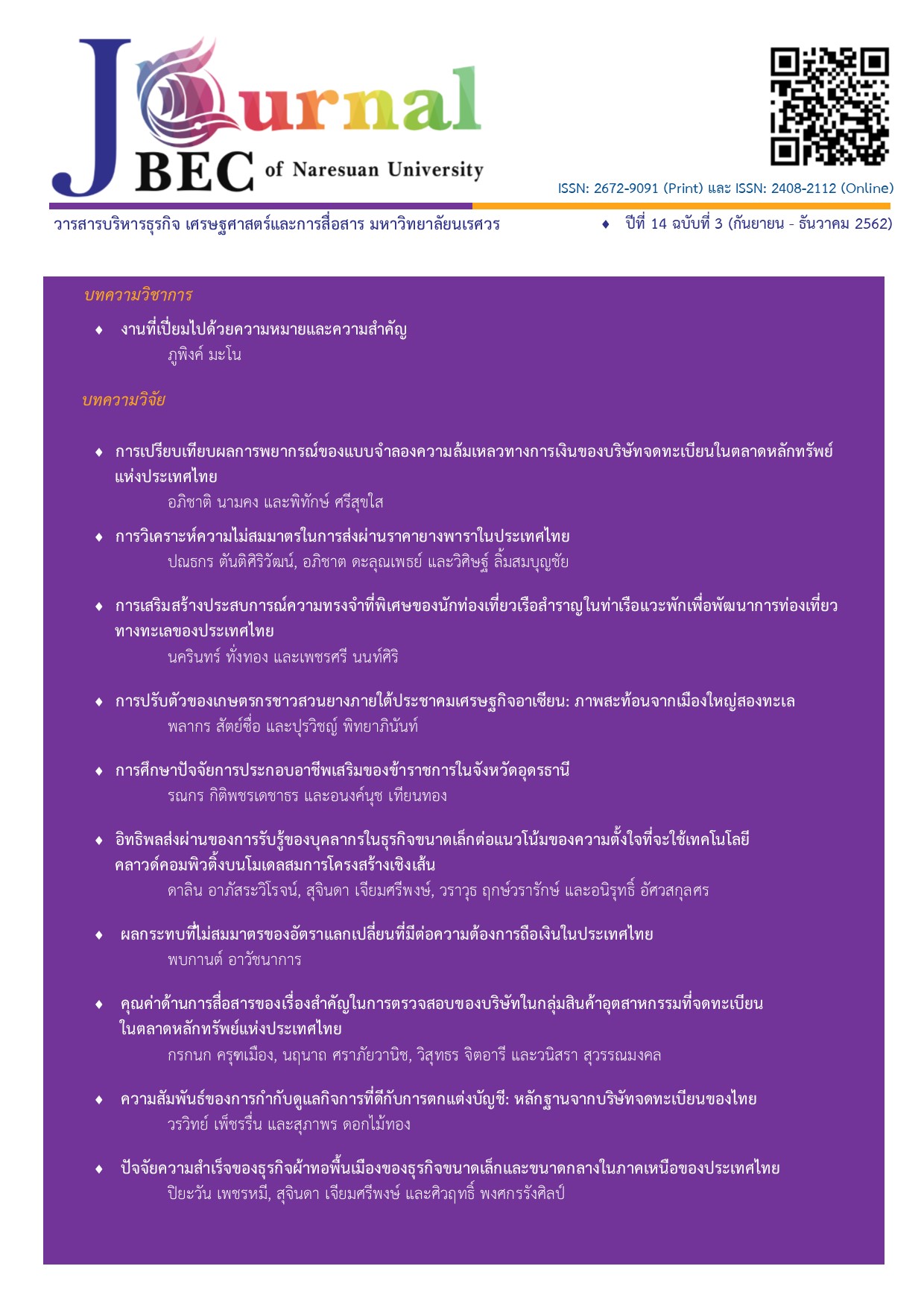Para-rubber Farmers’ Adaptation Practices under ASEAN Economic Community: A Reflection of the Large City of Two Seas
Main Article Content
Abstract
Abstract
This survey research investigated the para-rubber farmers’ adaptation practices under ASEAN Economic Community (AEC), and examined factors determining their adaptation practices under AEC. Songkhla province was selected as the research area. A survey of 400 representative para-rubber farmers in Songkhla province, was conducted using mixed method sampling. Primary data were collected using structured interviews. The derived data were then analyzed using descriptive statistics and an ordered logit model. The results identified that the para-rubber farmers had a low level of overall adaptation practices under AEC ( = 0.32±0.25) because of their limitations, e.g., knowledge and understanding of AEC. The adaptation practices with a livelihood aspect were at a moderate level (
== 0.46±0.35). The statistically significant factors determining the para-rubber farmers’ adaptation practices under AEC were: the adequacy of household labor for para-rubber farming, and the contact to government officers for assistance in para-rubber farming management, with respective probabilities of moderate level of adaptation practices of 0.1768, and 0.1457, respectively. The results are useful for related government agencies to formulate appropriate agricultural extension strategies.
Keywords: 1) Adaptation 2) Para-rubber Production 3) Para-rubber Farmer 4) Ordered Logit Model
5) ASEAN Economic Community (AEC)
Article Details
References
2. Agricultural Economics Operation Center, Office of Agricultural Economic. (2018b). Para-rubber: Plantation area, harvested area, yield, and productivity in 2016. Retrieved January 8, 2019, from http://www.oae.go.th/assets/portals/1/files/production/pararubber.pdf
3. Balassa, B. (1965). Trade liberalization and Revealed Comparative Advantage. The Manchester School of Economic and Social Studies, 33(2), 99–123.
4. Bharksuwan, S. (2014). Thailand’s preparation for ASEAN Economic Community. Rattasapasarn, 62(12), 48-70.
5. Bupsiri, A. (2013). Preparation of ASEAN Economic Community readiness by rice farmers in Aranyaprathet district of Sa Kaeo province. Master Thesis, M.Ag., Sukhothai Thammathirat Open University, Nonthaburi.
6. Fainanta, W. (2012). Entering ASEAN Economic Community (AEC) by longan farmers in Chiang Mai Province. Master Thesis, M.Ag., Sukhothai Thammathirat Open University, Nonthaburi.
7. Kispredarborisuthi, B. (2006). Techniques for developing data collection tools for research (6th ed.). Bangkok: Jamjuree Product.
8. Kongrithi, W., Thammachote, P. and Patcharat, S. (2017). A cointegration analysis of rubber price transmission from world price to Thai farm price. Journal of Southern Technology, 10(2), 67-76.
9. Liu, X. (2016). Applied ordinal logistic regression using Stata: From single–level to multilevel modeling. Thousand Oaks, CA: SAGE.
10. Maddala, G. S. and Lahiri, K. (2009). Introduction to econometrics (4th ed.). New Delhi: John Wiley and Sons.
11. Manopimoke, W. and Manopimoke, S. (2012). Success and consequence of ASEAN Economic Community participation: Primary review and research issues. Journal of Management Science, Ubon Ratchathani University, 1(1), 7-17.
12. Nirathron, N. (2012). Adaptive strategies of farmers affected by free trade agreement:
A challenge to the concept of “self-reliance”. Journal of HR Intelligence, 7(1), 21-33.
13. Phitthayaphinant, P. and Nissapa, A. (2012). An analysis of price trends and factors affecting Standard Thai Rubber 20 (STR 20) prices. Journal of Humanities and Social Sciences, Mahasarakham University, 31(4), 95-106.
14. Prasith-rathsint, S. (2007). Social science research methodology (14th ed.). Bangkok: Samlada.
15. Quiroga, S., Suarez, C. and Solis, J. D. (2015). Exploring coffee farmers’ awareness about climate change and water needs: Smallholders perceptions of adaptive capacity. Environmental Science and Policy, 45, 53-66.
16. Roopsing, T. (2011). Impacts and readiness of Thailand for ASEAN Economic Community participation. The Journal of Faculty of Applied Arts, 4(1), 71-80.
17. Sangworn, N. and Sawmong, S. (2014). Strategies for building a competitive advantage in Thai rubber to ASEAN Economic Community (AEC). Journal of the Association of Researchers, 19(1), 111-122.
18. Sirisuwat, P. and Jindabot, T. (2013). Strategies for the development of Thai rubber exported industry toward competition in the international markets. Executive Journal, 33(2), 40-48.
19. Somboonsuke, B., Dhammasaccakarn, W., Cherdchom, P., Longpichai, O. and Phitthayaphinant, P. (2015). Potential, capacity and development of hired labor in smallholding rubber production system: Lesson learned from traditional rubber area, Songkhla province. Kasetsart Journal of Social Sciences, 36(1), 74-87.
20. Sompong, S. and Sriwongkol, W. (2013). The impact of joining the ASEAN Economic Community (AEC) and measures to support the Thai rubber industry. Journal of Technical Education Development, 26(88), 44-51.
21. Thainthai, C. (2012). ASEAN Economic Community: Impact to Thai business community. Ph.D. in Social Sciences Journal, 2(2), 1-5.
22. Thaipukdee, M. (2012). Thailand and ASEAN Community: Opportunity and risk. Romphruek Journal, 30(3), 109-124.
23. Thuyen, P. T., Chaovanapoonphol, Y. and Jintrawet, A. (2014). Farmers’ perception and adaptation to climate pressure on highland robusta coffee production, Dak Lak, Vietnam. Khon Kaen Agriculture Journal, 42(2), 55-65.
24. Tubtimkeaw, W. and Thipbharos, T. (2015). Attitude of Thai farmers toward AEC: A case study of Ratchburi farmers. Suthiparithat, 29(92), 322-337.
25. Yamane, T. (1967). Statistics: An introductory analysis (2nd ed.). Tokyo, Japan: John Weatherhill.


